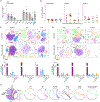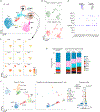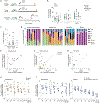A dynamic atlas of immunocyte migration from the gut
- PMID: 38181094
- PMCID: PMC10964343
- DOI: 10.1126/sciimmunol.adi0672
A dynamic atlas of immunocyte migration from the gut
Abstract
Dysbiosis in the gut microbiota affects several systemic diseases, possibly by driving the migration of perturbed intestinal immunocytes to extraintestinal tissues. Combining Kaede photoconvertible mice and single-cell genomics, we generated a detailed map of migratory trajectories from the colon, at baseline, and in several models of intestinal and extraintestinal inflammation. All lineages emigrated from the colon in an S1P-dependent manner. B lymphocytes represented the largest contingent, with the unexpected circulation of nonexperienced follicular B cells, which carried a gut-imprinted transcriptomic signature. T cell emigration included distinct groups of RORγ+ and IEL-like CD160+ subsets. Gut inflammation curtailed emigration, except for dendritic cells disseminating to lymph nodes. Colon-emigrating cells distributed differentially to distinct sites of extraintestinal models of inflammation (psoriasis-like skin, arthritic synovium, and tumors). Thus, specific cellular trails originating in the gut and influenced by microbiota may shape peripheral immunity in varied ways.
Conflict of interest statement
Figures







References
-
- Ruff WE, Greiling TM, Kriegel MA, Host-microbiota interactions in immune-mediated diseases. Nat Rev Microbiol. 18, 521–538 (2020). - PubMed
Publication types
MeSH terms
Grants and funding
LinkOut - more resources
Full Text Sources
Molecular Biology Databases

